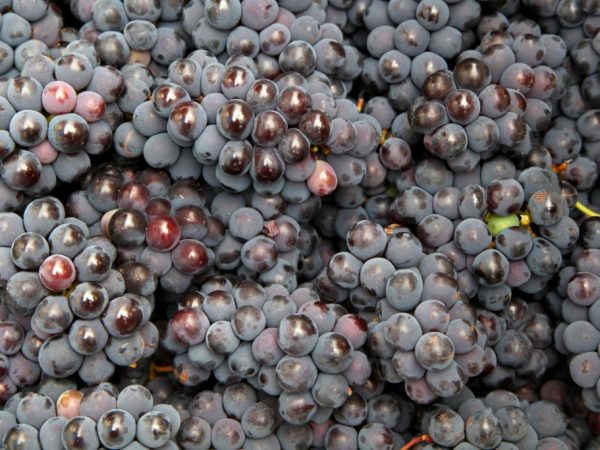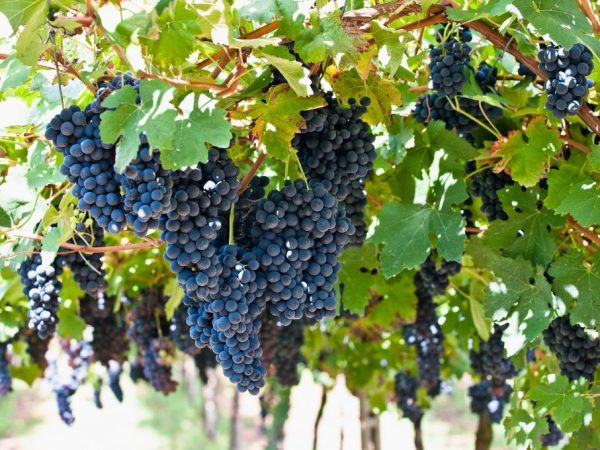Features of Marshal Foch grapes
There are 2 versions of the origin of Marshal Forsch grapes. Some say he is Riparia, crossed with Rupestris 101-14 and Goldrisling. Others write that it was derived from Oberlin 595 and the Goldriesling variety. Marshal Foch grapes are early maturing, vigorous growth and excellent shoot ripening.

Features of Marshal Foch grapes
Characteristic
France is the birthplace of this culture. It is used to make red and rosé wines.
The vegetative period of the plant is up to 125 days. The grapes begin to ripen at the end of August-September, depending on the sunshine.
The variety is resistant to cold and frost, survives cold from -32 ° C to -40 ° C without shelter.
Marshal Foch does not like high temperatures, he prefers sandy soil. It tolerates drought well.
Description of the bush
Young stems take root well during spring planting, the vine is distinguished by active growth.
The bushes have a large number of clusters, the average weight of which reaches 100-200 g. They must be pruned, since the branches grow quickly.
Description of berries
According to the description, the berries are deep blue, smooth, firm, with firm skin and small, which attracts the attention of birds.
They ripen in leaps and bounds. The maturity of the bunches evens out within a week. Sometimes the harvest has to be partially harvested, which is inconvenient for those with small vineyards.
Growing
Marshal Foch grapes grow on sandy soils, but sandy loam, clay and loamy are also well suited.
Before planting, prepare the soil: free it from excess vegetation (weeds), saturate it with useful elements like black soil or humus garden soil.
Fertilization is useful for grapes: both organic and mineral. On soil poor in minerals and nutrients, it is advisable to add compost obtained from kitchen, vegetable and garden waste.
It is better to buy a plant in containers: this way the root remains intact, and it is already saturated with fertilizers. In this case, the seedling is guaranteed to successfully take root.
Care

During the fruiting period, it needs watering
The plant must be fed with organic matter. Shelter in winter is optional.
For the first time, Marshal Foch grapes are pruned in the fall, when he reaches the age of 3 years. This allows you to achieve better plant productivity. The load on the bush should be 55-65 eyes.
Shoots break off in spring.
The plant needs watering only for drought. This is especially true for the fruiting period.
Diseases and pests
Protection from pests and diseases is one of the most important aspects of growing berry bushes. For this, chemical preparations are suitable, the treatment with which is carried out at the stage of plant development.
Common problems:
- Oidium. This disease manifests itself at the stage of bud opening and appearance of leaves. To fight the disease help drugs "Shavit", "Falcon", "Novopidon", "Tolendo", "Topaz".
- Black spot, gray rot, mildew, bunches.These ailments appear before flowering. To combat them, the means "Quadris" and "Match" are used. They guarantee the preservation of the integrity of the flowers for a month. At the end of flowering, Tiovit Jet, Akarin, Neoron and Ridomil Gold are used to combat mildew, oidium and ticks.
- Ground pests - beetle and scoop. Against them, the crown of the plant is treated with the drug "Antichrushch", "Aktara" or any other based on imidacloprid. After 1.5 months, spraying is repeated.
Prophylaxis
Be sure to carry out monthly disease prevention.
The first spraying is performed at a temperature of 4 ° C-6 ° C against diseases and rodents. The bushes at this time are sprayed with a 3% solution of copper sulfate. The vines must be put in order before this: it is important to cut off all shoots and leaves affected by the disease.
The next spraying is carried out as soon as young leaves are formed on the vine (after about 1.5-2 weeks). This time it is treated with a fungicide.
With symptoms of gray rot or oidium, the bushes are treated with a pink solution of potassium permanganate. In the case of powdery mildew, you can also use colloidal sulfur.
Conclusion
The Marshal Foch grape does not require special care: it shows resistance to cold weather, oidium, mildew. Its benefits do not end there. It is this variety that possesses the noble taste of Burgundy wine. A drink made from these berries has a high percentage of alcohol and sugar, which does not prevent it from being light and unobtrusive.


